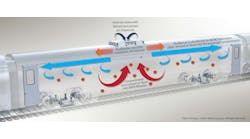After successful pilot, denser filters will be added throughout BART’s fleet of train cars
The Bay Area Rapid Transit (BART) will begin to install denser filters throughout its fleet of train cars following a successful pilot.
Air filtration has an important role in preventing transmission of the coronavirus, along with vigilant mask-wearing. BART's heating, ventilation and air conditioning (HVAC) systems are robust already, with air in a train car being replaced about every 70 seconds. Air filters are rated by their ability to block different-sized particles, a rating known as their minimum efficiency reporting value (MERV) on a scale from 1 to 20.
The old MERV-8 filters could trap particles between three and 10 microns in size; the new MERV-14’s can capture much smaller particles between .3 and one microns. BART engineers sent the pilot filters out for pressure-drop testing to measure their effectiveness.
“We’ve completed the evaluation and gotten the numbers back,” said Ben Holland, manager of Vehicle System Engineering. The pilot took about six months for the testing to occur after a train car had gone through its full preventative maintenance cycle of real-world operations. “We feel really confident about moving forward with the MERV-14s. We’ve set up stock numbers for them to be implemented fleet-wide.”
Overall, the air in BART trains at a given moment is about 75 percent filtered and 25 percent fresh air drawn from outside the car (it’s 80/20 on legacy trains and 70/30 on Fleet of the Future trains).
The new MERV-14 filters are being incorporated into inventory and purchasing systems. They’ll be installed in every car as it goes into the shop for its scheduled preventive maintenance.
“As each car comes in, they’ll pull out the MERV-8s and put in MERV-14s,” Holland said.
Fleet of the Future trains have a modernized HVAC system which, in addition to other benefits, includes total air flow increased from 4000-cubic feet per minute to 4300; supply air ducts on the ceiling for better air flow and more cooling for standees; improved design against refrigerant leakage; and switching from an ozone-depleting refrigerant to an environmentally friendly one.
The modern HVAC units also continually communicate their performance status to the train operator and can provide fault logs and diagnostic functions to help with troubleshooting.
Update on UV-C lighting test
BART is exploring many different technologies. Another pilot, which is testing an ultraviolet UV-C lighting rod inside one legacy train car’s undercarriage HVAC unit, is still in the evaluation phase but looks promising, Holland says.
“We’re still monitoring that,” Holland said. “So far it’s been working well. We’re still trying to figure out how to replicate that into Fleet of the Future HVAC units.”
More good news from the UV pilot, he says, is that engineers have refined the design in order to put two UV-C bulbs instead of one, in addition to using bulbs that are 50 percent longer than in the original pilot design.
“We’ll get three times as much light output – it’s almost like installing three bulbs. We’re still in the process of finalizing the electrical and mechanical details.”
The only hurdle may be finding suppliers.
“It’s been really frustrating working with suppliers who are under the gun from everybody,” Holland said.
BART will work with Bombardier, the manufacturer of the new trains, so that the UV-C lighting can become standard-issue from the factory.
“We are working on the design in-house because if we rely entirely on them to produce a design, it could take quite some time,” he said. “This is urgent and important to us and to our customers.”
BART engineers have had preliminary discussions with scientists from the Lawrence Livermore National Laboratory regarding simulations that can mimic a sneeze or cough to quantify the flow and travel of aerosols, tiny airborne particles that can carry coronavirus or other pathogens.
“We’re in all talks with all kinds of different agencies,” Holland said. “This is being watched and scrutinized all over the world. It’s hugely important for our public.”
BART tests disinfecting robot
Chief Safety Officer Jeff Lau said BART is “actively evaluating many different technologies” that could potentially be used in the transit system to combat the coronavirus.
One product, a robot that could run through cars in their off-hours and spray disinfectant, was tested but probably won’t move forward because of difficulties in accessing the trains and moving between them, Lau says. (Trains already are disinfected with electrostatic foggers, which are applied by a human, at night.)
A smaller, Roomba-like device that can vacuum and disinfect at the same time will also get a test run.
“We are open to all different kinds of technologies and innovations,” Lau said. “We are trying to be a leader in the industry in keeping our patrons and employees safe. I’m very confident that our system will be as safe, maybe even safer, than before Covid-19, thanks to enhanced cleaning and changes in behavior like wearing masks.”


